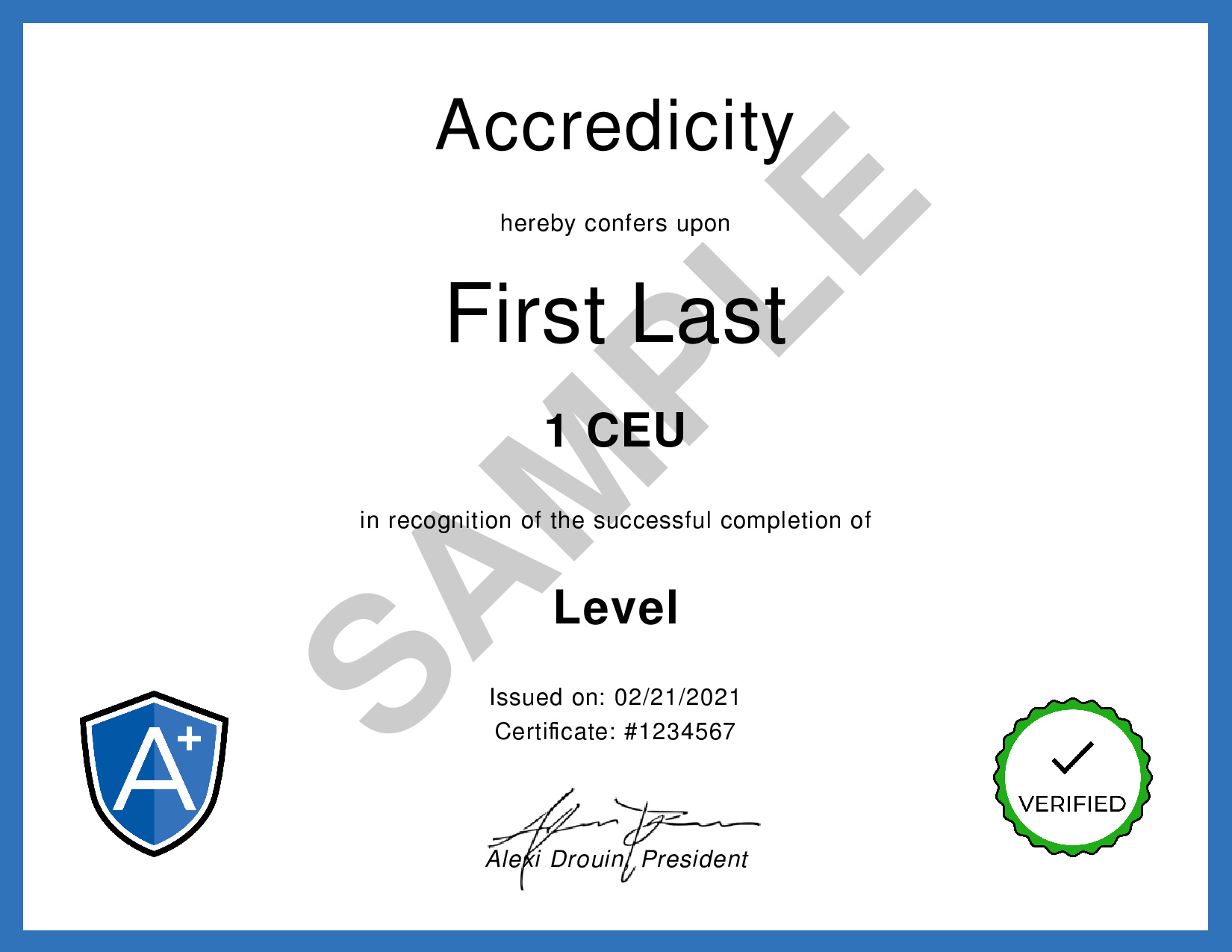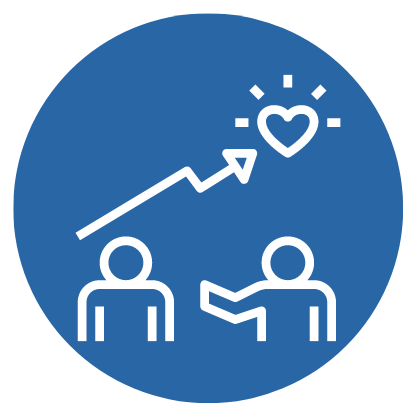Feedforward | Marshall Goldsmith
Reference: Marshall Goldsmith. (2014, August 26). Feedforward: Coaching For Behavioral Change [Video]. YouTube.
We Make Your Education Count

Get the Credit You Deserve and Become the Most Attractive Job Candidate by Earning and Posting A+ Badges to Your Linkedin Profile.
Sign Up to Get Started at Accredicity
Captivate: Science of Succeeding with People | Vanessa Van Edwards | Talks at Google
 94 Creds - Communication
94 Creds - Communication|
Discover the power of feedforward: Learn how to help yourself and others with a positive, upbeat coaching process! Marshall Goldsmith introduces the concept of feedforward - a positive and upbeat way to help yourself and others get better. It's a key component to his coaching process and involves two roles: learn as much as you can and help as much as you can. The rules of feedforward include no feedback about the past and no judgement or critiquing of ideas - treating the idea like a gift and saying thank you. It can be done with a team or large group, and the goal is to talk to as many people as possible. People often find this exercise positive, simple, helpful, and even fun. Feedforward focuses on the future, is fast, simple, and positive, and involves no judgement. It encourages better listening and giving recognition for good ideas. Everyone is focused on helping each other, making it a powerful tool for behavioral change. Learning Outline1. No feedback about the past Instructional ContentFeedforward is a powerful coaching technique to help individuals and teams make positive changes in their lives and careers. It is a simple process that encourages open and honest dialogue between those involved in order to allow for meaningful and effective change. By eliminating the need for judgement or critique, feedforward allows for constructive dialogue that is focused on helping each other, rather than judging or critiquing each other. At the heart of the feedforward process are two key roles: learning as much as possible and helping as much as you can. Each person involved is asked to choose one area of their life where they would like to make improvements. During the process, each person is given the opportunity to listen to one or two ideas from their peers without judgement or critique and to express their gratitude. Feedforward is fast, simple, positive and focused on the future. It is an exercise that is often seen as fun, rather than painful. It eliminates the need for judgement and critique, allowing for meaningful dialogue and progress to occur. It also eliminates the need to rehash the past and allows for a focus on the future. Feedforward is a powerful and effective coaching technique that can help individuals and teams make positive, meaningful changes. By eliminating judgement and being focused on helping each other, feedforward can create an environment that encourages open and honest dialogue and can lead to real and lasting changes. Communication
|

Feedforward is a simple process that helps people learn and grow. It’s like giving and receiving gifts. You can’t judge or critique the gift, you just say thank you and appreciate it. You also don’t talk about the past, since you can’t change it anyway. Instead, you focus on the future and give each other one or two quick ideas for improvement. It’s fast, positive, and even fun! Everyone is working together to help each other, so it’s like a big party instead of a boring lecture. Video Quotes1. "No feedback about the past. We spend too much time in our lives talking about the past." - Marshall Goldsmith Related Quotes"The way to get started is to quit talking and begin doing." - Walt Disney "The best way to predict the future is to create it." - Peter Drucker "Coaching is unlocking a person's potential to maximize their own performance." - Tim Gallwey Competencies1. Constructive Feedback Learning Outcomes1. Remember: Students should be able to recall the core elements of feedforward, including the two roles, rules, and goals. 2. Understand: Students should be able to understand the purpose of feedforward and its significance in interpersonal communication. 3. Apply: Students should be able to apply the concepts of feedforward in their own lives, such as treating input as a gift, avoiding feedback about the past, and not judging or critiquing ideas. 4. Analyze: Students should be able to analyze the advantages and disadvantages of feedforward and compare it to other forms of feedback. 5. Evaluate: Students should be able to evaluate the effectiveness of using feedforward and develop strategies for improving their communication skills. 6. Create: Students should be able to create their own feedforward exercises for themselves and for others and develop an action plan for incorporating feedforward into their daily lives. Sample Answers1. In this video I learned about feedforward, a key component of the coaching process. This process is focused on helping other people improve, rather than judging them. It involves two roles: learning as much as you can and helping as much as you can. 2. The two rules of feedforward are: no feedback about the past and no judging or critiquing of ideas. This is because it is impossible to change the past and judging or critiquing ideas does not help anyone to improve. 3. Feedforward is simple, positive, and even fun because it is fast, focused on the future, and encourages people to be thankful for ideas instead of judging them. This exercise can be done with large groups and can help people learn more from each other than they would have otherwise. Marshall GoldsmithMarshall Goldsmith is a world-renowned executive coach and New York Times best-selling author. He is a Fellow in the National Academy of Human Resources, a Distinguished Leadership Fellow from the American Management Association, and a Distinguished Faculty at the Leadershape Institute. He is a two-time Thinkers50 #1 Leadership Thinker in the World and the first-ever recipient of the Lifetime Achievement Award from the International Coaching Federation (ICF). He is the founder of Marshall Goldsmith Group, a company that specializes in executive coaching. Feedforward is a coaching technique developed by Marshall Goldsmith that focuses on future behavior rather than past behavior. Marshall Goldsmith Learning DesignThe competencies of Constructive Feedback, Coaching, and Integrity and Trust are all essential for successful communication. Constructive feedback provides an opportunity to exchange ideas and information in a respectful and open manner, while coaching provides the skills to direct and motivate others. Integrity and trust are essential for any communication to take place in a meaningful and effective way. In order to build these competencies, learners can use a combination of instructional techniques such as lectures, role-playing, discussions, and case studies. Lectures can provide the basic information and understanding of the topics. Role-playing can be used to practice the skills in a safe environment, while discussions allow learners to engage in meaningful conversations with peers. Finally, case studies provide an opportunity to apply the concepts to real-life scenarios. Learners can also benefit from reflection exercises that allow them to identify areas for improvement and focus their learning on the most important topics. This can be done through journaling, self-assessments, and individual or group projects. By combining these instructional techniques and activities, learners can develop the competencies of Constructive Feedback, Coaching, and Integrity and Trust. This will enable them to communicate more effectively in the workplace and beyond. AssessmentQ: What is the 2nd rule of feedforward? QuestionsCommon Hypothetical Questions: Real-Life Examples and Scenarios: KeywordsFeedforward Coaching, Behavioral Change, "No Feedback Past", "Help Nice People", "Treat Idea Gift", "Non-Defensive Listening", "No Critique Judging" Facts1. Feedforward is a positive, upbeat way of helping yourself and others to improve. Trends1. Create an online course to teach the principles of feedforward. SourceThis learning instructional guidance was formulated using the GPT-3 language model created by OpenAI. ShareLearn #Feedforward: A positive, upbeat way to help yourself & others get better. Focus on the future, treat ideas like gifts, & help each other. #Coaching #Lifelessons #Growth 🔆 @Accredicity |












